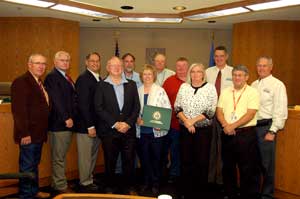Watershed Assessment Team Commended

An agreement between the Oklahoma Conservation Commission and USDA Natural Resources Conservation Service (NRCS) was signed in September 2009 for the purpose of completing assessments of 141 high hazard watershed dams across the state. The dams, located in 59 watershed projects in 40 conservation districts and 39 counties, are classified as high hazard because of the potential for loss of life should one of the dams fail during a flooding event.
The success of the project depended on the ability of the team members to work from different locations around the state, including remote sites, but to coordinate work and share data on a daily basis. That was made possible through a central computer server and high speed Internet connections. The following people, several of whom are retired NRCS employees, were selected for the team, operating under the supervision of OCC’s Conservation Programs Division in collaboration with NRCS:
- Larry Caldwell, project coordinator
- Jim Henley, GIS specialist
- Ray Riley, engineer and hydrologist
- Dwain Phillips, technical writer/editor
- Lil Holkum, secretary and data management
- George Moore, watershed technician
- Dennis Boney, watershed technician
- Johnny Pelley, watershed technician
- Mike Sharp, OCC information technology (IT) support
- Gary Utley, NRCS support
- Tammy Sawatzky, OCC support
- Robert Toole, OCC support
Members of the team attended the November 2011 meeting of the Oklahoma Conservation Commission (OCC). OCC Chairman George Stunkard, accompanied by NRCS State Conservationist Ron Hilliard, presented Conservation Commendations to all members present, which stated “In appreciation of your participation in the Watershed Rehabilitation Assessment Project 2009-2011.” Project coordinator Larry Caldwell gave a presentation on the purpose, scope and findings of the assessment project.
The assessment process included
- on-site dam inspections,
- video inspection of principal spillway pipes,
- Light Detection and Ranging (LiDAR) imagery of sites used with GIS and hydrologic modeling to develop breach inundation maps
- checking conformance with state dam safety requirements
- development of site-specific rehabilitation alternatives
- preparation of of cost estimates for rehabilitation alternatives based on historic cost data
The assessment report for each dam included
- Description of the condition of the dam and appurtenances
- Breach inundation analysis and map
- Identification of homes and roads within the area flooded if the dam should fail
- Verification of hazard classification
- Status of the operation and maintenance of the dam
- Conceptual rehabilitation alternatives, including site-specific restraints
- Estimated cost ranges for rehabilitation alternatives
- Priority ranking spreadsheets.
Findings
- All dams assessed needed some degree of operation and maintenance (O&M), totaling an estimated $657,000 statewide. Thirteen dams had “urgent” needs related to cuts, seepage, sinks, leakage, spillway blockages or other issues.
- Of 46 principal spillways video inspected, almost all were in good condition, but some had cracks or other problems.
- A total of 1,685 potential damage locations were identified downstream from the dams, some impacted by more than one dam, with inundation depths tabulated. Three dams may have hazard classification reduced because no potential damage locations were found in the breach inundation area.
- The total number of people who could potentially be threatened if a dam should fail was computed for each dam.
- Most breach inundation areas extended further than originally expected. (The median was eight miles.)
- The total estimated cost for rehabilitating the 141 dams to meet NRCS and Oklahoma Water Resources Board safety standards is $225,000,000.
Recommendations to Watershed Sponsors
Recommendations resulting from the assessment reports for project sponsors to complete included
- Updating emergency action plans for each dam to included breach inundation maps
- Immediately address actions identified as urgent to help keep dams safe
- Follow up with recommended O&M
- Work with OWRB to possibly lower the classification of identified dams
- Determine high priority dams to submit requests for NRCS rehabilitation.
